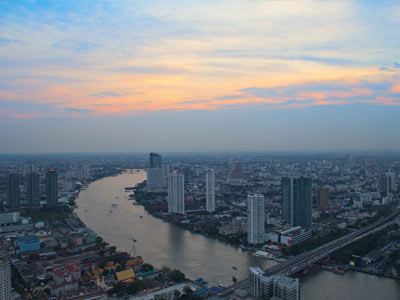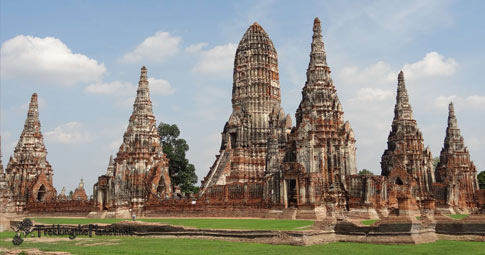Thailand
Country statistics

Land area: 197,595 sq miles (511,771 sq km)
Total area: 198,455 sq miles (514,000 sq km)
Population (2011 est.): 66,720,153 (growth rate: 0.566%); birth rate: 12.95/1000; infant mortality rate: 16.39/1000; life expectancy: 73.6
Capital City: Bangkok
Monetary unit: baht
Languages: Thai, English (secondary language of the elite), ethnic and regional dialects
Ethnicity/race: Thai 75%, Chinese 14%, other 11%
Religions: Buddhist 94.6%, Muslim 4.6%, Christian 0.7%, other 0.1% (2000)
Country introduction

Thailand located in South-east Asia, shares its border with Myanmar in the west and north, Laos in the north-east, Cambodia in the east and Malaysia in the south.
Thailand's diverse geographical regions include the central area (encompassing the Bangkok Metropolitan Region) that comprises the basin of the Chao Phraya River that runs from north to south and after crossing Bangkok flows to the Gulf of Thailand. The central region is often called the "rice bowl" of Thailand being the most fertile area of the country. After the Bangkok Metropolitan Region, it enjoys the highest per capita income in the country.
The northern region is mountainous and was traditionally the most heavily forested area of the country. In the recent years, however, overcutting has considerably reduced its forest resources. The main centres of population are in the narrow alluvial valleys along the four north-south flowing rivers which unite in the northern central plain to form the Chao Phraya.
The north-eastern region (Isarn) constitutes approximately one third of the area of the Kingdom and comprises the Korat Plateau which is bounded on the north and east by the Mekong River and the south by the Dongrek escarpment. The region is drained by the Mun and Chi rivers, both tributaries of the Mekong. Largely owing to lower and erratic rainfall and poorer soils than in other parts of the country, the north-eastern provinces have the lowest per capita income in the country. Approximately one third of the population of Thailand lives in the north-east.
The south-east comprises of hilly countrysides from Bangkok to the Cambodian border, and is characterized by higher rainfall and poorer soils than the adjoining central region. It is an important fruit, maize and cassava-growing area and its coastline offers extensive opportunities for fisheries and tourism. The high rainfall also permits some rubber to be grown.
The southern peninsula has the highest rainfall in the country. It is the principal rubber-growing area and contains extensive alluvial deposits of tin. The forests of the south have been seriously overcut as elsewhere in the Kingdom. In recent years, the region has suffered from severe floodings which are believed to have been amplified by deforestation and subsequent soil erosion.
The culture

Thailand literally means "Free Land" or "land of the free people". The country is unique in South-east Asia in that it never was subjected to European colonial domination. So, the Thai people have been developing and refining their culture for centuries.
The culture of Thailand incorporates a great deal of influence from India, China, Cambodia, and the rest of South-east Asia. Thailand's national religion Theravada Buddhism is central to modern Thai identity and belief. In practice, Thai Buddhism has evolved over time to include many regional beliefs originating from Hinduism, animism as well as ancestor worship. In areas in the southern-most parts of Thailand, Islam is prevalent. Several different ethnic groups, many of which are marginalized, populate Thailand. Some of these groups overlap into Myanmar, Laos, Cambodia, and Malaysia and have mediated change between their traditional local culture, national Thai and global cultural influences. Overseas Chinese also form a significant part of Thai society, particularly in and around Bangkok. Their successful integration into Thai society has allowed for this group to hold positions of economic and political power.
Like most Asian cultures, respect towards ancestors is an essential part of Thai spiritual practice. Thais have a strong sense of hospitality and generosity, but also a strong sense of social hierarchy. Seniority is an important concept in Thai culture. Elders have by tradition ruled in family decisions or ceremonies. Older siblings have duties with respect to younger ones.
The traditional greeting gesture is called a wai (hands placed together in a prayer position at the chest, chin or forehead). There are various levels of wais, the best is to just imitate the wai that is being given to you. Most Thais are not accustomed to shaking hands, but more are adopting this Western approach when meeting foreigners.
Thais have a deep reverence for the Royal Family, especially the King. His Royal Majesty King Bhumibol Adulyadej is the world's longest reigning monarch and a multi-talented one at that. He is a sailor, an artist, a musician, and an agriculturalist. His love of sailing has inspired an annual regatta called The King's Cup which is held on Phuket Island during the week of the King's birthday (5 December). It is a major event, attracting sailors and spectacular yachts from around the globe.
Thai cuisine blends five fundamental tastes: sweet, spicy, sour, bitter and salty. Some common ingredients used in Thai cuisine include garlic, chillies, lime juice, lemon grass, and fish sauce. The staple food in Thailand is rice, particularly jasmine variety rice (also known as Hom Mali rice) which is included in almost every meal. Thailand is the world's largest exporter of rice, and Thais domestically consume over 100 kg of milled rice per person per year. Over 5000 varieties of rice from Thailand are preserved in the rice gene bank of the International Rice Research Institute (IRRI), based in the Philippines.
There are countless festivals and special events held in Thailand throughout the year. Two of the most popular nationwide annual celebrations are "Songkran" the water festival and "Loy Krathong" when candle-lit offerings are floated in the rivers, canals lakes and the sea. Other festivals are specific to particular cities or provinces. With a number of Thai festivals and Buddhist holidays, the exact date varies each year because it depends on the lunar calendar and the night of the full moon.
Attractions & landmarks

The home to the earliest Bronze Age civilization Thailand is a nation with a rich and colorful history. Visitors looking to take in some of this extraordinary past can visit the ruins of Ayutthaya, which was the old capital from around 1350 until it was sacked and destroyed by the Burmese in 1767. While only a shadow of the glory that once was, the old city still shows off its former magnificence and visitors can feel like the King of Siam as they wander through the former Royal Palace and nearby ancient temples. Highlights include the temple of Wat Phra Chao Phanan Choeng, a 14th century temple that boasts an enormous 19m high image of Bhudda. Also of note is the Wat Phra Meru which escaped the ravages of the Burmese and is home to a 1300 year old green rock carving of a throned Bhudda. Located about 80 km (50 miles) north of modern day Bangkok the visit to Ayutthaya Historical Park is certainly worth the visit.
After taking in the old, tourists can contrast this ancient city with Bangkok's historic center at Rattanakosin Island, which features the Grand Place, built for the coronation of Rama I in the late 1700s. There are also various royal temples worth looking at with the Temple of the Golden Buddha being significant, as it houses an enormous 5 tonne statue of Buddha rendered in solid gold. The most famous market is the Wat Sai Market but it has become somewhat commercial in recent years so seeking out floating markets in other areas of the country is highly recommended. In particular the Damnoen Saduak floating market is considered the best of these uniquely Thai experiences. The nightlife in Bangkok is lively and there are plenty of bars and clubs. Many travellers are drawn to the lewd displays of the Patpong bars but in other areas of the city there is enough variety to cater for most tastes.
Chiang Mai is Thailand's second city was founded in 1296 and sits against the backdrop of the impressive Doi Suthep mountain. The city is a lot less crowded and manic than Bangkok and many travellers prefer its slightly more relaxed atmosphere. One of the key attractions is the Night Bazaar which is located in the centre of the city and a great place to do a spot of souvenir shopping or just to practice your haggling. The city is also a base for a variety of mountain treks, most give visitors the opportunity to see the hill tribes to the north of the city and some are even conducted on elephant back. No traveller should leave without visiting the 'chedi' at the top of Doi Suthep, the Wat Phra Borommathat temple situated there is reknowned as one of the holiest in Thailand.